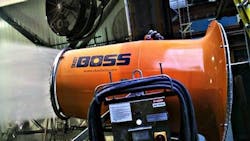A New York heavy construction firm is smothering dust from underground blasting operations by using a network of suppression equipment, as the rough-in work for the 2nd Ave. Subway Project in Manhattan is completed.
SSK Constructors (Schiavone/Shea/Kiewit) is charged with demolition of existing buildings to construct the station entrances and ancillaries, mining of the 72nd Street Station Cavern, as well as shafts and adits for the entrances and ancillaries, and mining the G3/G4 tunnel to connect the 72nd Street Station to the existing stub tunnels at 63rd Street. The work is all part of a planned $4.45 billion expansion of the New York City Subway System.
“We’re drilling and blasting, which is an effective way to dislodge large volumes of material at a time,” said SSK Project Coordinator Frank Townsend. “The potential drawback is that it creates dust and smoke, and since this is one of the busiest sections of the city, we knew we had to find an effective control method.”
Like most contractors, excavation crews had relied primarily on manual spraying with fire hoses to keep dust down in the past. “That’s a labor-intensive approach, often requiring several workers at a time, and it’s not as efficient,” Townsend said.
Townsend estimated that at a $100,000 annual cost per worker in New York City (counting benefits and insurance), the company may have been expending as much as $1 million per year for its attempts at dust management.
To eliminate manual spraying and cut costs, SSK purchased four DustBoss machines from Dust Control Technology in Peoria, Ill., a specialist in atomized mist technology for dust suppression and large-scale water evaporation.
The suppression equipment at the 2nd Ave. site is strategically positioned to maximize droplet exposure to airborne dust particles and increase hang time. “When we blast, a tremendous amount of energy is released,” Townsend explained. “The force carries the dust away from the shot, and if not contained, it would find its way out the tunnel and up the shafts, which could take it out to the street.”
To accommodate the conditions, crews set up the machines pointed in the same direction as the blast force travel, with two stationed at each of the vertical shafts. “By aiming the units along the path that the dust will travel, we give the atomized mist more time to collide with dust particles and drive them to the ground,” Townsend said.
The mobile machines have motors ranging from 7.5 to 25 horsepower, and the largest employs a series of 30 specially designed brass nozzles to atomize the water into droplets 50-200 microns in size, a key size for particle attraction. With the 25-horsepower motor generating 30,000 cubic feet per minute, the atomized spray has a range of more than 200 feet.
“The units have had a big impact on this project,” Townsend concluded. “Our air monitoring systems confirm the significant dust reduction.”
Expected to open in 2016, the 2nd Ave. line will add two tracks to help alleviate congestion on Manhattan’s upper east side – an area currently served by just one line.
Source: Dust Control Technology

